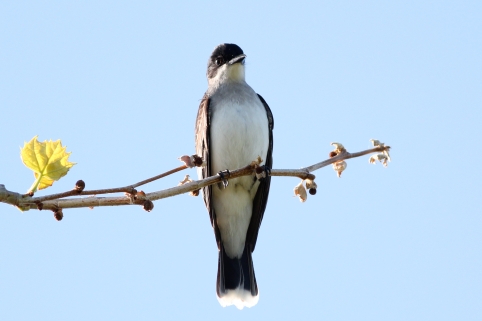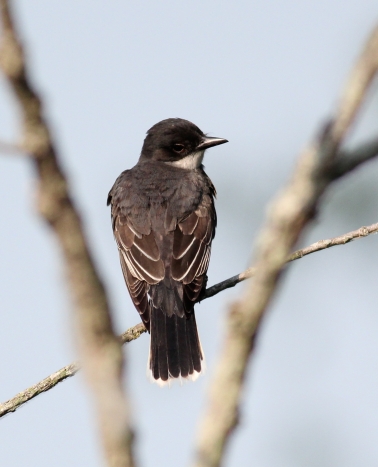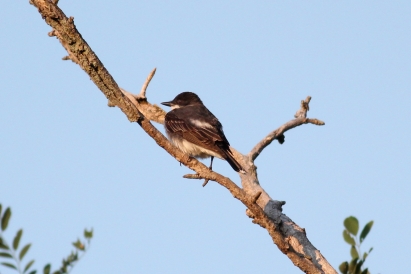In my last post I declared the Osprey as the “king bird” of my yard on the Chesapeake Bay. Since then I received some guff from another corner. The smaller, tuxedoed, bird that formally lays claim to the moniker Kingbird, can back this up with the Latin genus and species of Tyrannus tyrannus and its aggressive behavior toward any other bird, big or small. You’d normally expect the “king” to be large predator like a buteo or maybe an eagle, not a smallish bird that eats flies. But despite its size this bird is clearly the territorial policeman.
As flycatchers go this one is relatively large. I’ve been thinking about it these days as it’s about to take off for South America. We’ll miss its antics. As the yard’s enforcer it will attack any bird flying over its territory including the much larger crows, herons, and even other stray kingbirds. Even the Blue Jays shrink from the king. Luckily the Osprey are fish-eaters and not a direct threat to the Kingbirds. They seem to tolerate each other in the yard, even with nearby nests, and both leave for the south and return in the spring at about the same time.
Even though this bird is not a visitor to feeders and bird baths, it is relatively easy to spot. Look especially for the white narrow band at the tip of the tail. Rarely you may glimpse a small red crown feather when the bird is displaying. Like a king, this birds perches majestically in plain sight on trees and shrubs scanning for bugs. Its efficient aerial hawking for bugs usually results in his return to the same branch, time after time. This trait allows the observer, and especially the photographer time to set up the perfect shot. This bird is not like the elusive warbler that will not sit still.
The Eastern Kingbird, like other Tyrant flycatchers, is in the suboscine group of passerines that have a primitive syrinx and resultant simple song repertoire, likely in-bred rather than learned.
Unfortunately, all its behavior is not regal. The Kingbird is an intra-specific brood parasite. Apparently the stress of wearing the crown occasionally gets just too great and the burden of feeding another mouth too much to bear, and she will lay an egg in the nest of another Kingbird. At least it’s another Kingbird nest and only a sporadic trait, but this, after making such a scene of defending its own nest and territory seems so hypocritical.
This fall, when these birds head south, they’ll really go all the way, leaving the continent for the warmth of the Amazon River Basin. Their behavior also changes in S. America where they become much more gregarious, living in flocks. Even their diet changes to include fruit. When they return next spring, there is a good chance that it will be the same bird, meeting the same mate, and perching on the same tree. The reign continues.







Very interesting! I always learn a lot and really enjoy your blog.
LikeLiked by 1 person
Thanks for your kind words. It has been fun posting these.
LikeLike
You are so fortunate to see all the birds that you do. I love seeing the Kingbird but do so rarely. I find it interesting for the bird to travel so far, then return to the same place again. It really is sad when their tree is gone like seems to be happening more and more with development. Living in wetlands does offer them protection though. Other birds are not always so lucky.
LikeLiked by 1 person
The Kingbird is one of the constants in our summer yard, along with the N. Mockingbird and the Osprey. Their interactions and antics make for good entertainment. Thanks again for your interest.
LikeLike